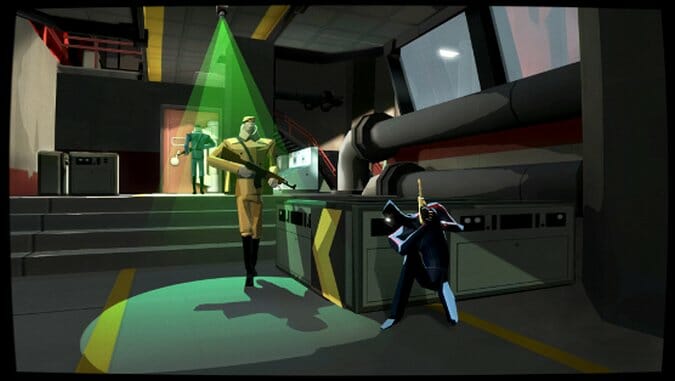CounterSpy (PS3, PS4, Vita)

As a dyed-in-the-wool save scummer, I’ve developed muscle memory for pausing and hitting the analog stick the exact number of times to hit the restart option in just about every stealth game I’ve played. If I’m ever seen or accidentally kill someone, it’s mission failed, start over. Hope you remembered to quicksave after you got past that single guard. Nonlethal, never spotted. Yes, I’m that guy. Obsessive, to be sure, but I don’t mind following the same path over and over as long as I’m enjoying myself. There’s a satisfaction in perfecting a route, and stealth games scratch that itch.
CounterSpy offered very little to the save scummer in me, but that meant that I could live a little within its confines. I was more than welcome to start the level over should I be spotted or killed, but every level is heavily randomized, so if I did, I wouldn’t benefit from the knowledge of my last attempt. The nonlethal options, similarly, are pretty slim; in my playthrough they amounted to a single gun that I didn’t acquire until later in the game, meaning that a no-kill run was basically impossible on my first playthrough. The game’s statistics don’t include guards bypassed, and you don’t get score bonuses for having avoided enemy encounters. If I had managed to go undetected on any level (which I sure didn’t), my only reward would likely be the time bonus I’d get for not having stopped to engage in firefights, but that again does not seem likely.
Unable to have another real go at a mission that bested me or finish every mission nonlethally, my perfectionist tendencies fell to the wayside in favor of a much more aggressive approach. Avoiding guards and cameras is still the best option, since both can raise DEFCON level (more on that in a bit) if they spotted me, but I was more than likely going to win the ensuing firefight. Guards go down in one headshot (helmets later prevent this) and I had more than enough ammo to drop everybody in the level and then some, which meant I didn’t exactly have to be choosy about when to ice guards from afar or approach them. With the help of a few perks equipped before the mission as well as generously-placed med stations, I could survive from one firefight to another without too much hassle. In short, I played CounterSpy the way most people play other stealth games: sneak around until I got caught, then kill my way back to an undetected state.
It sounds reductive, but the loop works. You have enough options to kill guards silently, whether it’s with a silenced pistol, a twist of the neck, or a toss off the edge of a catwalk. I could win firefights, but that didn’t mean I could waltz in on four guys in the open and expect to get out alive. Hidden objectives and upgrade schematics make looking around and risking detection worth the risk, but being spotted or dying means raising the DEFCON level. Raising the level above DEFCON 1 triggers a one-minute timer to get to the end of a level and prevent a nuclear strike. The DEFCON level also carries over between missions, so screwing up royally in one mission means making the next that much harder on yourself. It’s a tenuous balance, but most of the time it works well enough that you’re wary of raising the DEFCON level but are tempted enough by secret paths and goods to look around and risk being caught.
Not reflexively jumping for the restart button took some time to get used to, but I had fun raising hell. Playing CounterSpy was like venting my latent frustration at other stealth games or games that require trial-and-error level design: I would throw caution to the wind as I sprinted to the next door, get spotted, say “well fuck it then!” and be rewarded with dead guards a clear path forward. And it felt good. But even as I went back to it time and again, enjoying myself at every turn, I felt something missing. The game didn’t need save scumming, nonlethal options or anything of the sort. It was aiming to set itself apart from other stealth games in that regard, and it did so laudably. But it needed something.
